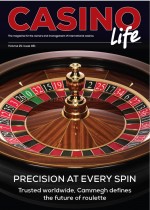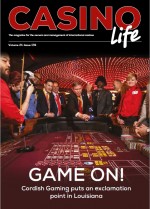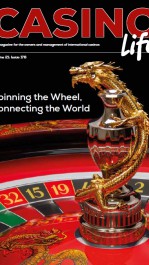How to improve your product performance, and do something nice for slot players at the same time Victor H. Royer
Skill games are here – well, soon, at least, once the rules are finalized. Get ready for Pac-Man, Mario Bros, Centipede, Pinball, Frogger, Space Invaders, and Hemorrhoids (Umm, I mean, Asteroids). Frankly, I just can’t wait – for the skill games, I mean. Not the Hemorrhoids.

In my case, and for anyone who was around in the 1970’s and 80’s, these Arcade Games are what we played everywhere. As young adults, or younger still, it didn’t matter – these were the games that weaned the gamers in all of us. And now that we are casino gamers, well, it’s about time – we are ready, waiting, and will gladly see our favorite arcade games finally pay us back some of the many thousands of quarters we all fed into them, back in the day.
But this brave new world of slots is not just about all things skill-based. There are plenty of other kinds of games for the casino floor, and many of them are just as great, and just as interesting. And some even profitable (for all of the participants, be they the manufacturer, the casino, or the player). I have featured many of these new games in my latest book: “Great Casino Slots – Volume 1”, and the soon-to-be-released “Great Casino Slots – Volume 2”. In each of these books I show the range of the latest new slot product that is being offered to casinos around the world. And, of course, to casino players.
Here in North America, primarily in the United States, casino operators are always scrambling for the latest, greatest, and hottest new games. And there is a definite flux in all of these things, be they games from the major OEM’s, or some newer offerings from a range of smaller manufacturers. As the old-timer prospector would say: “There’s gold in them thar hills!” Yes, that’s true. But increasingly the “gold” – meaning the percentage of the casino floor – is being contested much more forcefully, and much more frequently.
While in years past the Juggernaut that was IGT often commanded some 70%-80%, or more, of the casino floor, today that’s down to just around 50% in many casinos, and falling steadily. It’s no surprise, therefore, that the prognosis for IGT is a continuing reduction of floor-share, further reducing their footprint by some 20% to 30% over the next 2-3 years. Or perhaps sooner. Other manufacturers are now seen as having better product, and – in some cases – also better service. Especially compared to the “old” IGT – the one that’s still struggling.
But it’s not just IGT that’s facing these issues. It’s the industry as a whole. We are now in a fast-changing paradigm, where all things as they used to be aren’t necessarily the things as they ought to be. And while casino operators are struggling to find the most viable balance for their slot floor, and get the best-possible deals they can squeeze out of the manufacturers in the process, equally so the manufacturers are struggling to meet the needs of not just casino operators, or shareholders of the much-merged OEM’s, but increasingly so the very fickle casino players.
Although the core casino customer – the gambler – remains a fairly steady and reliable source of revenue, many of the more casual casino players are becoming much more used to expecting things that are “new”, and this directly translates to expectations in the kinds of games that they will play. While WMS, for example, has great product that catches the interest of the players as soon as it hits the casino floor, the fact remains that much of that product then fades as players become familiar with it, how it plays, pays, and what it does. This is not an issue particular to WMS – all manufacturers face similar challenges in the creation of product that lasts – and each new offering is yet another entry into the lottery of “what will stick and stay.”
But my point is that not all of these challenges – and not all of these “expectations of new things” – are necessarily the cause of all the winners and losers in gaming machine manufacture.
OK, so we all know that several OEM’s are gaining and losing, a little bit here and there, sometime between 5% and 10% or so, depending on the region and the operator – but that’s in some way to be expected. IGT cannot remain as the Juggernaut it once was, simply and purely because there are now a lot more manufacturers than there were in years past. And customers, and casino players, who demand more and more, and new and new, and different offerings. It’s called “progress” – whether good or bad, well, we can’t tell just yet. But, in a sense, we know, anyway.
But – you see – many of the issues of “longevity on the casino floor”, and “interest from the casino players”, have much more to do with the way in which the new casino slot machines are made – rather than with the actual content of the games. And these problems have a lot more to do with the design of the box, instead of the design of the game.
There’s been a whole slew of industry “buzzing” about a series of slot machine cabinets, such as Wave – and all of the other similar-style cabinet designs which are kind-of like uprights, but more so like slant-tops – in which designers have been creating something that they all think is great and wonderful. Well, yes, it is – it looks great, and is wonderful at the gaming show. But on the casino floor? Well – fixed-seating notwithstanding – can you spot the one thing that’s a problem with ALL such designs?
Google the design, look at the pictures, and think – can you see it?
Let me give you a hint – it has something to do with the actual usage of the device in the actual casino, under actual in-casino play by real casino players. See it? OK, I’ll tell you …
It’s the feet.
Yup. And the legs.
See it now?
All of these designs cram the player’s legs under the “lip” of the machine, right in an area where it gets really hot – even after only a few moments of sitting – and where the player’s legs become bent for long periods of time, causing cramps, restricted blood flow, and fatigue.
And the feet?
Well, see it? There’s no place to “put your feet up.”
On traditional slots – those that sit on cabinets – there’s room on either side of the machine for the player to put their feet up, then lean back into the seat, comfortably, and play. In this way, the player can easily play for several hours, and with little fatigue.
But on these “new” designs that’s not possible. And the same applies to all slant-tops, too.
Combine that with the fact that these new designs – and slant tops – require players to keep “bending forward” to push the buttons, and you have a prescription that says: “I can only stand this for a few minutes, and then I gotta go.”
Result? No longevity of the game, player attrition, loss of player interest in the game, loss of revenue for the casino and the manufacturer, and – in the end – puzzlement by both the operator and the OEM as to “what went wrong?” Why isn’t this great game doing as good as it did in focus groups? Or in trials?
Hmmm … ?
Well, that’s why.
Because you made it uncomfortable to the Nth degree by these designs – which do not take into account the actual use of them by actual players in actual casinos under actual in-casino playing conditions.
Don’t agree?
Well then … YOU try to sit there for 3 hours, and see how YOU feel!
Why 3 hours?
Because a real casino player, and slot enthusiasts – people like me – well, we WILL play that long, and longer. IF – that is – we are comfortable!
And right now – on most of these new games and slant-tops – the fact is that we just aren’t. We ache and hurt much too soon, and that makes us want to go somewhere else – to anything, anywhere – even if just to stretch out our tired, hot, cramped and bent legs – and sore feet.
And that’s why there is this great and complex fluctuation of winners and losers in slot product – and all because of a seemingly great disconnect between what is a great idea in the laboratory, but a lousy way to play a slot machine.
Solution?
Easy – put elevated foot-rests on the underside of the cabinet – either side – and make the “lip” narrower so the player can “put their feet up.” Then move the buttons closer to the edge of the “lip” so the players can push them while leaning back, instead of having to “bend forward” and cramp their bellies in the process, while also straining the lower back at the same time.
Do this, and you’ll be amazed at how much better your product results will be. And even if they should not be that much better – wouldn’t it be nice to do something good for the slot players?
===========================================================
Victor H Royer is President of Gaming Services & Research. He is a 33 year veteran of Las Vegas gaming, a 25 year consultant to the gaming industry, and author of 40 books on casino games and gaming. In addition he has researched and authored more than 300 industry reports on the subject of player preferences, marketing, player development and customer relations, and published over 4,000 articles on casino games and the casino industry. He can be reached at: DrVHR@aol.com































